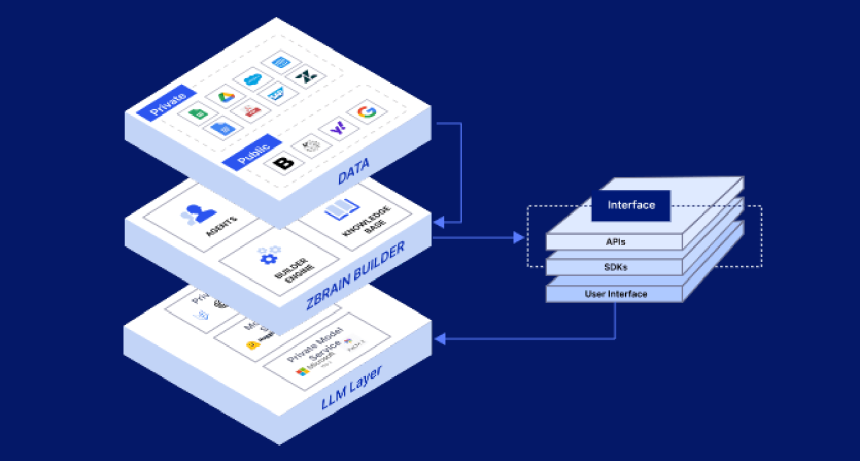In today’s competitive digital economy, businesses are relentlessly searching for smarter ways to leverage their data. Artificial Intelligence (AI) has become the go-to solution for extracting actionable insights, optimizing operations, and predicting outcomes. However, traditional monolithic AI systems often fall short in terms of scalability, adaptability, and customization.
This is where cutting-edge innovations like ZBrain’s Modular AI Stack and ZBrain XPLR come into play. These technologies are changing the game by enabling organizations to construct highly customizable, efficient, and exploratory AI systems that align with their unique business goals.
Let’s explore how these tools are transforming enterprise intelligence.
The Challenges of Traditional AI Systems
Many enterprises initially embraced AI with the hope of rapid digital transformation. However, they soon encountered challenges, including:
- High integration costs with legacy systems
- Inflexible architecture
- Lack of scalability
- Limited control over data privacy and compliance
- Difficulty in experimentation and iteration
As a result, businesses needed a more dynamic approach—something modular, adaptable, and built for real-time business demands.
Enter Modular AI: A Paradigm Shift
Modular AI refers to a system design philosophy that breaks down the AI architecture into independent yet interoperable components. This architecture empowers organizations to assemble and scale AI capabilities like building blocks.
Why Modular AI?
- Scalability: Easily scale individual components based on workload and business needs.
- Customizability: Tailor specific modules (e.g., data ingestion, model inference, visualization) to suit domain-specific requirements.
- Faster Time-to-Market: Plug-and-play modules accelerate development and deployment cycles.
- Reduced Technical Debt: Updates or improvements can be made to specific modules without overhauling the entire system.
This modular approach is foundational to ZBrain’s strategy for AI deployment, giving businesses a distinct competitive edge.
Understanding ZBrain’s Modular AI Stack
The ZBrain’s Modular AI Stack is a comprehensive framework that helps organizations seamlessly develop, deploy, and scale AI systems. It covers the entire AI lifecycle—from data collection to model serving—with a high level of granularity.
Core Components of the Modular Stack
- Data Connectors: Secure and flexible integration with various data sources including cloud, on-premise, and hybrid storage.
- Preprocessing Engines: Customizable pipelines for data cleaning, transformation, and enrichment.
- Model Orchestration: AutoML and manual configuration options to train, validate, and deploy machine learning models.
- Inference Layers: Real-time and batch prediction capabilities with version control.
- Monitoring and Governance: Built-in compliance features, audit logs, and usage analytics.
By adopting this modular stack, businesses can move beyond rigid, one-size-fits-all solutions and build AI applications that are truly aligned with their operations.
Exploring Deeper with ZBrain XPLR
Innovation doesn’t stop at modularity. Once your AI system is up and running, the next challenge is to understand why it’s making certain decisions and how those decisions impact your business. This is where ZBrain XPLR becomes indispensable.
What Is ZBrain XPLR?
ZBrain XPLR is an interactive exploratory platform designed to make AI models more transparent, interpretable, and trustworthy. It bridges the gap between data science and business intelligence by offering:
- Visual Dashboards: Drag-and-drop interface for creating real-time visualizations of AI outputs.
- Model Explainability: Tools like SHAP, LIME, and saliency maps to interpret predictions.
- Scenario Simulation: Test “what-if” scenarios to understand how different inputs affect outcomes.
- Data Provenance: Track the origin and transformation of data throughout the pipeline.
Business Use Cases of ZBrain XPLR
- Financial Services: Validate lending models to ensure compliance and reduce bias.
- Healthcare: Understand diagnosis predictions and track medical decision accuracy.
- Retail: Simulate inventory decisions to maximize revenue and reduce waste.
- Manufacturing: Predict equipment failure and optimize maintenance schedules.
These capabilities make ZBrain XPLR a vital companion for any enterprise that wants to stay agile, compliant, and customer-focused.
Benefits of Combining Modular AI and Exploratory Platforms
Together, modular AI systems and exploratory tools create a holistic AI environment that is not only efficient but also trustworthy and business-aligned.
Key Advantages
- End-to-End Visibility: Understand every step from data ingestion to final decision-making.
- Agility: Modify, replace, or scale individual components without disrupting operations.
- Informed Decision-Making: Use exploratory tools to validate model predictions and make strategic adjustments.
- Regulatory Compliance: Maintain transparency in line with GDPR, HIPAA, and other regulatory standards.
- Collaborative Development: Enable cross-functional teams to interact with AI systems in intuitive ways.
By aligning technological flexibility with business strategy, organizations can create AI systems that are not only powerful but also adaptable and accountable.
Future Outlook: AI as a Living Ecosystem
The next decade of enterprise AI will be defined by how well businesses can manage complexity, adapt to change, and leverage data responsibly. Rigid, closed-loop systems will continue to lose relevance as organizations prioritize agility, transparency, and sustainability.
Solutions like ZBrain’s Modular AI Stack and ZBrain XPLR represent the future of enterprise AI—modular, interpretable, and purpose-built. They don’t just enhance what AI can do; they redefine what’s possible.
Conclusion
AI is no longer a luxury—it’s a necessity. But for AI to truly deliver value, it must be modular enough to scale, exploratory enough to understand, and tailored enough to fit your unique business environment.
Adopting a solution like ZBrain’s Modular AI Stack empowers enterprises to build adaptive, scalable AI ecosystems. Complementing that with ZBrain XPLR ensures these systems remain transparent, trusted, and strategically aligned.
Together, they offer a blueprint for AI success—one that is intelligent by design, and insightful by execution.
READ ALSO: Wall Street on edge as US stocks tumble amid bleak economic forecast and investor concerns













